Mobile Eye Tracking during Experimenting with Digital Scaffolding—Gaze Shifts between Augmented Reality and Experiment during Zinc Iodide Electrolysis Set-Up
Abstract
:1. Introduction
1.1. Self-Directed Experimenting
1.2. Sequential Scaffolding
1.3. Augmented Reality
1.4. Eye Tracking
1.5. Research Questions
2. Materials and Methods
- Heading: Chemistry Redox reaction—electrolysis of a zinc iodide solution (Chemie Redoxreaktion—Elektrolyse Zinkiodid)
- Instruction (Arbeitsauftrag): Set up and conduct the experiment (For safety during the experiment there is also the following hint: three drops of the zinc iodide solution are sufficient, along with a symbol for safety glasses)
- Evaluation (Auswertung): … see additional worksheet
- Tip (Tipp): After 5 min you will see the result and can finish the electrolysis.
- Set-up (Aufbau): Two succeeding AR-hints
- Conducting the experiment (Durchführung): One video hint
- Observation of the experiment (Beobachtung): One image hint
- Checkboxes: Hint 1 viewed?/Hint 2 viewed?
- Description below the AR marker (Set-up/Aufbau): Pull off and open with app
- Description below the QR Codes: Pull off and scan QR
2.1. Eye Tracking Glasses and Software
2.2. Sample
2.3. Data Collection
2.4. Data Analysis
3. Results
3.1. Hint 1/Experiment
3.2. Hint 2/Experiment
3.3. Short Interview
4. Discussion
Author Contributions
Funding
Institutional Review Board Statement
Informed Consent Statement
Data Availability Statement
Acknowledgments
Conflicts of Interest
Appendix A


References
- Baur, A.; Hummel, E.; Emden, M.; Schröter, E. Wie offen sollte offenes Experimentieren sein? Ein Plädoyer für das geöffnete Experimentieren [How open should open experimentation be? A plea for open experimentation]. MNU J. 2020, 72, 125–128. [Google Scholar]
- Eckhardt, M.; Urhahne, D.; Conrad, O.; Harms, U. How effective is instructional support for learning with computer simulations? Instr. Sci. 2013, 41, 105–124. [Google Scholar] [CrossRef]
- Sommer, K.; Pfeifer, P. Experiment und Erkenntnis [Experiment and cognition]. In Konkrete Fachdidaktik Chemie; Sommer, K., Wambach-Laicher, J., Pfeifer, P., Eds.; Aulis: Seelze, Germany, 2018; pp. 70–88. [Google Scholar]
- Maiseyenka, V.; Schecker, H.; Nawrath, D. Kompetenzorientierung des naturwissenschaftlichen Unterrichts. Symbiotische Kooperation der Entwicklung eines Modells experimenteller Kompetenz [Competence orientation of science education. Symbiotic cooperation of the development of a model of experimental competence]. Phys. Didakt. Sch. Hochsch. 2013, 1, 1–17. [Google Scholar]
- Arnold, J.; Kremer, K.; Mayer, J. Scaffolding beim Forschenden Lernen. Eine empirische Untersuchung zur Wirkung von Lernunterstützungen [Scaffolding in inquiry-based learning. An empirical investigation of the effect of learning supports]. ZfDN-Zeitschrift Für Didaktik Der Naturwissenschaften 2017, 23, 21–37. [Google Scholar] [CrossRef]
- Hmelo-Silver, C. Problem-based learning: What and how do students learn? Educ. Psychol. Rev. 2004, 16, 235–266. [Google Scholar] [CrossRef]
- Bell, R.L.; Smetana, L.; Binns, I. Simplifying Inquiry Instruction. Sci. Teach. 2005, 72, 30–33. [Google Scholar]
- Schumacher, A. Forschendes Lernen im Chemieunterricht [Inquiry-based learning in chemistry education]. In Chemie Vermitteln. Fachdidaktische Grundlagen und Implikationen; Reiners, C.S., Ed.; Springer Spektrum: Berlin/Heidelberg, Germany, 2017; pp. 177–191. [Google Scholar]
- Affeldt, F.; Markic, S.; Eilks, I. Über die Nutzung abgestufter Lernhilfen beim forschenden Lernen [On the use of sequential scaffolds in inquiry-based learning]. Chem. Sch. 2019, 34, 17–21. [Google Scholar]
- Banchi, H.; Bell, R. The Many Levels of Inquiry. Sci. Child. 2008, 46, 26–29. [Google Scholar]
- Van Gog, T.; Hoogerheide, V.; Harsel, M. The Role of Mental Effort in Fostering Self-Regulated Learning with Problem-Solving Tasks. Educ. Psychol. Rev. 2020, 32, 1055–1072. [Google Scholar] [CrossRef]
- Van Gog, T.; Rummel, N.; Renkl, A. Learning how to solve problems by studying examples. In The Cambridge Handbook of Cognition and Education; Rawson, J.D.K., Ed.; Cambridge University Press: Cambridge, UK, 2019; pp. 183–208. [Google Scholar]
- Stäudel, L.; Franke-Braun, G.; Schmidt-Weigand, F. Komplexität erhalten—Auch in heterogenen Lerngruppen: Aufgaben mit gestuften Lernhilfen [Maintain complexity—Even in heterogeneous learning groups: Tasks with sequwntial scaffolding]. In CHEMKON: Forum für Unterricht und Didaktik; Wiley-VCH: Weinheim, Germany, 2007; Volume 14, pp. 115–122. [Google Scholar]
- Wieczorek, R.; Sommer, K. Strukturen nachweisen—Gestufte Lernhilfen und deren Einsatz bei eigenverantwortlichen Schülerexperimenten [Detecting structures—Sequential scaffolds and their use in independent student experiments]. Unterr. Chem. 2008, 19, 88–93. [Google Scholar]
- Renkl, A.; Atkinson, R.K. Structuring the transition from example study to problem solving in cognitive skills acquisition: A cognitive load perspective. Educ. Psychol. 2003, 38, 15–22. [Google Scholar] [CrossRef]
- van Harsel, M.; Hoogerheide, V.; Verkoeijen, P.; van Gog, T. Examples, practice problems, or both? Effects on motivation and learning in shorter and longer sequences. Appl. Cogn. Psychol. 2020, 34, 793–812. [Google Scholar] [CrossRef]
- Van Merriënboer, J.J.G. Training Complex Cognitive Skills: A Four-Component Instructional Design Model for Technical Training; Educational Technology Publications: Englewood Cliffs, NJ, USA, 1997. [Google Scholar]
- Foster, N.L.; Rawson, K.A.; Dunlosky, J. Self-regulated learning of principle-based concepts: Do students prefer worked examples, faded examples, or problem solving? Learn. Instr. 2018, 55, 124–138. [Google Scholar] [CrossRef]
- Azuma, R.T. A Survey of Augmented Reality. Teleoper. Virtual Environ. 1997, 6, 355–385. [Google Scholar] [CrossRef]
- Milgram, P.; Takemura, H.; Utsumi, A.; Kishino, F. Augmented Reality: A Class of Displays on the Reality-Virtuality Continuum. Telemanip. Telepresence Technol. 1994, 2351, 282–292. [Google Scholar] [CrossRef]
- Krug, M.; Czok, V.; Weitzel, H.; Müller, W.; Huwer, J. Gestaltungsparameter für Lehr-Lernszenarien mit Augmented-Reality-Anwendungen im naturwissenschaftlichen Unterricht—Ein Review [Design parameters for teaching-learning scenarios with augmented reality applications in science education—A review]. In Digitalisation in Chemistry—Digitales Lehren und Lernen an Hochschule und Schule im Fach Chemie; Graulich, N., Huwer, J., Banerji, A., Eds.; Waxmann: Münster, Germany; New York, NY, USA, 2021; pp. 51–57. [Google Scholar]
- Thyssen, C. Augmented Reality (AR) in der naturwissenschaftlichen Unterrichtspraxis [Augmented reality (AR) in science teaching practice]. In Lernprozesse mit Digitalen Werkzeugen Unterstützen; Meßinger-Koppelt, J., Schanze, S., Groß, J., Eds.; Joachim Herz Stiftung: Hamburg, Germany, 2017; pp. 177–191. [Google Scholar]
- Garzon, J.; Kinshuk; Baldiris, S.; Gutierrez, J.; Pavon, J. How do pedagogical approaches affect the impact of augmented reality on education? A meta-analysis and research synthesis. Educ. Res. Rev. 2020, 31, 100334. [Google Scholar] [CrossRef]
- Akçayır, M.; Akçayır, G. Advantages and challenges associated with augmented reality for education: A systematic review of the literature. Educ. Res. Rev. 2017, 20, 1–11. [Google Scholar] [CrossRef]
- Buchner, J.; Zumbach, J. Die Förderung von TPACK durch den Learning-Technology-by-Design-Ansatz [The Promotion of TPACK through the Learning-Technology-by-Design-Approach] In Neue Impulse in der Naturwissenschaftsdidaktik; Zumbach, J., Maresch, G., Fleischer, T., Strahl, A., Eds.; Waxmann: Münster, Germany; New York, NY, USA, 2020; Volume 8, p. 271-248. [Google Scholar]
- Huwer, J.; Lauer, L.; Seibert, J.; Thyssen, C.; Dorrenbacher-Ulrich, L.; Perels, F. Re-Experiencing Chemistry with Augmented Reality: New Possibilities for Individual Support. World J. Chem. Educ. 2018, 6, 212–217. [Google Scholar] [CrossRef]
- Probst, C.; Fetzer, D.; Lukas, S.; Huwer, J. Effekte von Augmented Reality (AR) zur Visualisierung eines dynamischen Teilchenmodells—Virtuelle Modelle zum Anfassen [Effects of Augmented Reality (AR) for the visualization of a dynamic particle model—Virtual models to touch]. Chemkon 2022, 29, 164–170. [Google Scholar] [CrossRef]
- Bolzer, M.; Strijbos, J.W.; Fischer, F. Inferring mindful cognitive-processing of peer-feedback via eye-tracking: Role of feedback-characteristics, fixation-durations and transitions. J. Comput. Assist. Learn. 2015, 31, 422–434. [Google Scholar] [CrossRef]
- Cullipher, S.; Hansen, S.J.R.; VandenPlas, J.R. Eye-Tracking as a Research Tool: An Introduction. In Eye-Tracking for the Chemistry Education Researcher; VandenPlas, J.R., Hansen, S.J.R., Cullipher, S., Eds.; American Chemical Society: Washington, DC, USA, 2018; pp. 1–9. [Google Scholar]
- Just, M.A.; Carpenter, P.A.A. A Theory of Reading: From Eye Fixations to Comprehension. Psychol. Rev. 1980, 87, 329–354. [Google Scholar] [CrossRef] [PubMed]
- Cullipher, S.; VandenPlas, J.R. Using Fixations to Measure Attention. In Eye-Tracking for the Chemistry Education Researcher; VandenPlas, J.R., Hansen, S.J.R., Cullipher, S., Eds.; American Chemical Society: Washington, DC, USA, 2018; pp. 53–72. [Google Scholar]
- Rodemer, M.; Eckhard, J.; Graulich, N.; Bernholt, S. Decoding Case Comparisons in Organic Chemistry: Eye-Tracking Students’ Visual Behavior. J. Chem. Educ. 2020, 97, 3530–3539. [Google Scholar] [CrossRef]
- Van Gog, T.; Paas, F.; Van Merrienboer, J.J.G. Uncovering Expertise-Related Differences in Troubleshooting Performance: Combining Eye Movement and Concurrent Verbal Protocols. Appl. Cogn. Psychol. 2005, 19, 205–221. [Google Scholar] [CrossRef]
- Holmqvist, K.; Nyström, M.; Andersson, R.; Dewhurst, R.; Jarodzka, H.; Van de Weijer, J. Eye-Tracking: A Comprehensive Guide to Methods and Measures; Oxford University Press: New York, NY, USA, 2011. [Google Scholar]
- Nehring, A.; Busch, S. Chemistry Demonstrations and Visual Attention: Does the Setup Matter? Evidence from a Double-Blinded Eye-Tracking Study. J. Chem. Educ. 2018, 95, 1724–1735. [Google Scholar] [CrossRef]
- Scheiter, K.; Eitel, A. The Use of Eye-Tracking as a Research and Instructional Tool in Multimedia Learning. In Eye-Tracking Technology Applications in Educational Research; Was, C., Sansosti, F., Morris, B., Eds.; IGI Global: Hershey, PA, USA, 2017; pp. 143–165. [Google Scholar]
- Blascheck, T.; Kurzhals, K.; Rascheke, M.; Burch, M.; Weiskopf, D.; Ertl, T. Vizualization of Eye Tracking Data: A Toxonomy and Survey. Comput. Graph. Forum 2017, 26, 260–284. [Google Scholar] [CrossRef]
- Blascheck, T.; Schweizer, M.; Beck, F.; Ertl, T. Visual Comparison of Eye Movement Patterns. Comput. Graph. Forum 2017, 36, 87–97. [Google Scholar] [CrossRef]
- Burch, M.; Timmermans, N. Sankeye: A Visualization Technique for AOI Transition. In Proceedings of the 2020 Symposium on Eye Tracking Research and Applications, Stuttgart, Germany, 2–5 June 2020; Volume 48, pp. 1–5. [Google Scholar]
- Fleischer, T.; Deibl, I.; Strahl, A.; Moser, S.; Maier, S.; Zumbach, J. EXBOX-Digital—Praxisorientiertes Unterrichtskonzept zum Einsatz digitaler Medien im Chemie- und Physikunterricht [Practice-oriented teaching concept for the use of digital media in chemistry and physics education]. In Neue Impulse in der Naturwissenschaftsdidaktik; Zumbach, J., Maresch, G., Fleischer, T., Strahl, A., Eds.; Waxmann: Münster, Germany; New York, NY, USA, 2020; Volume 8, pp. 211–223. [Google Scholar]
- Tobii Pro AB. Tobii Pro Glasses 2: Product Description, 1.95 ed.; Tobii Pro AB: Danderyd, Sweden, 2018. [Google Scholar]
- Tobii Pro AB. Tobii Pro Lab User Manual, 1.145 ed.; Tobii Pro AB: Danderyd, Sweden, 2014. [Google Scholar]
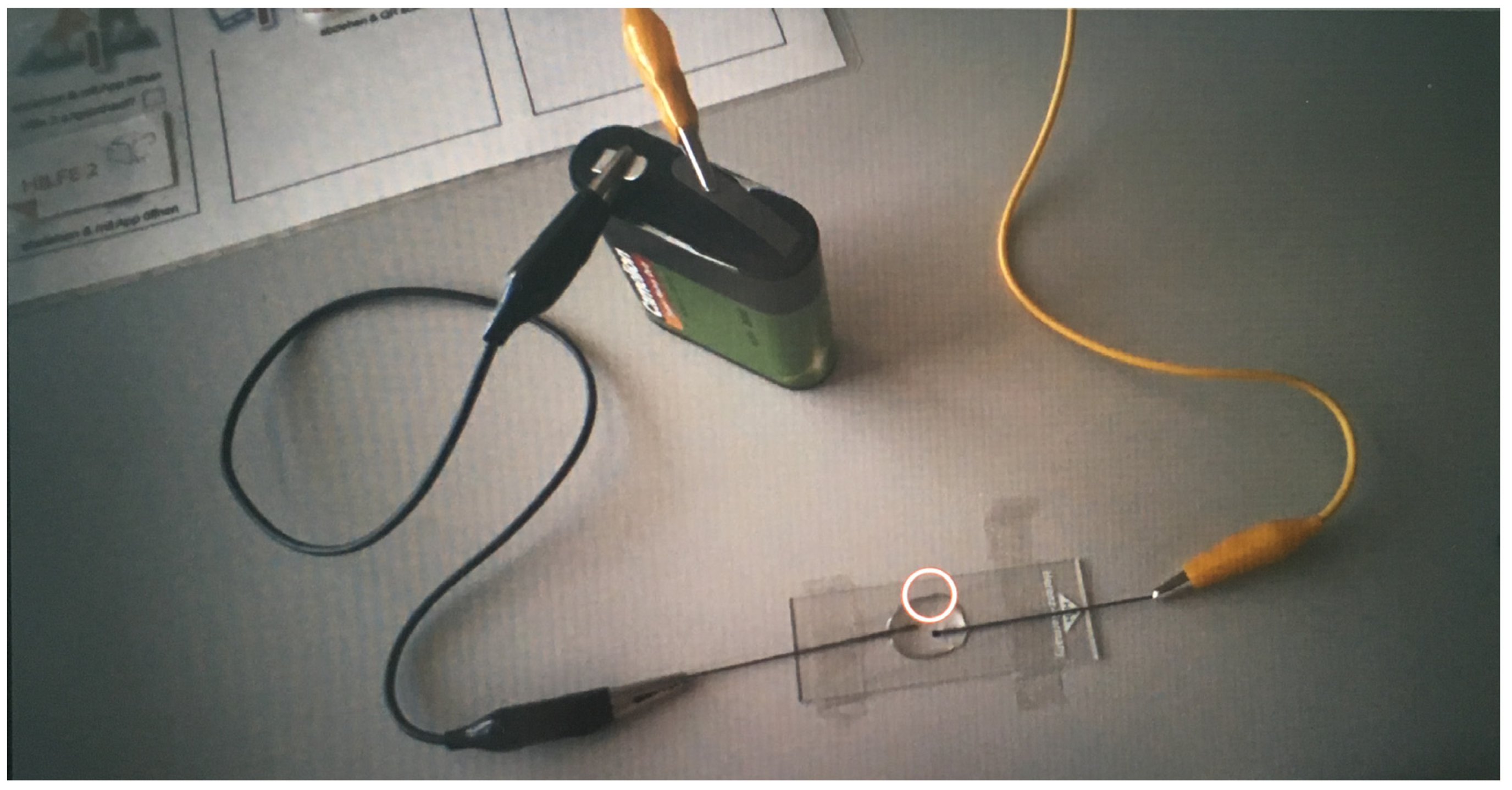

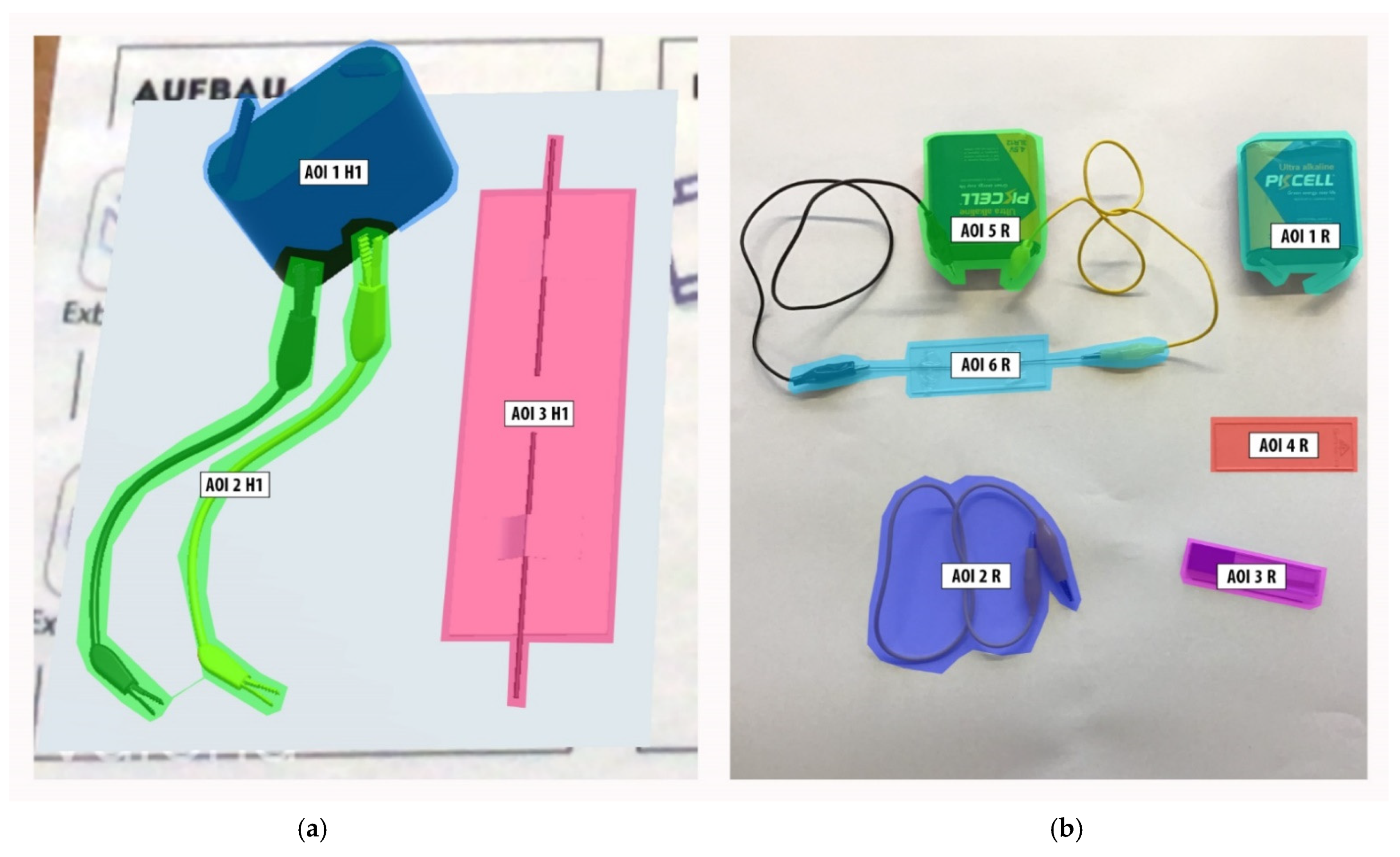
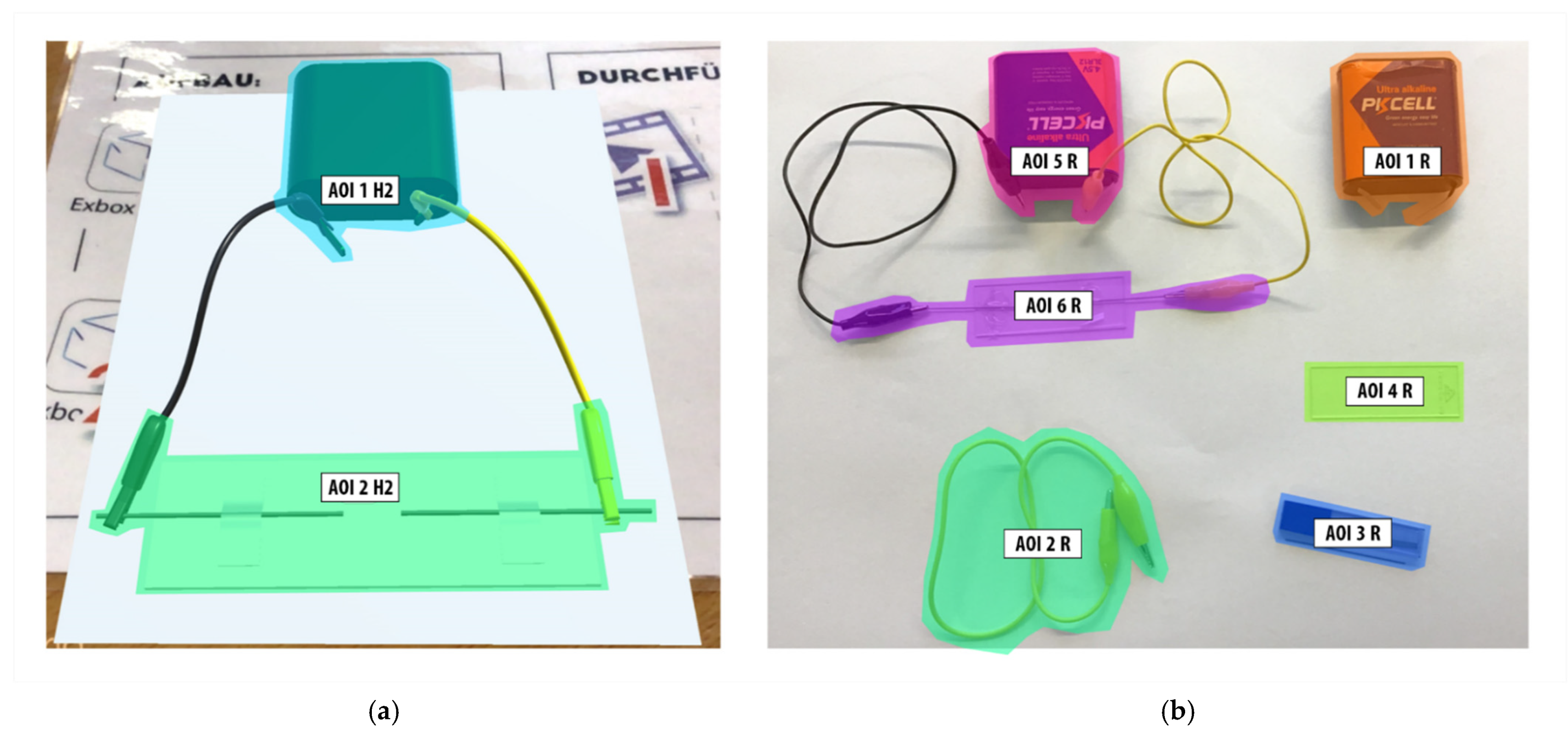
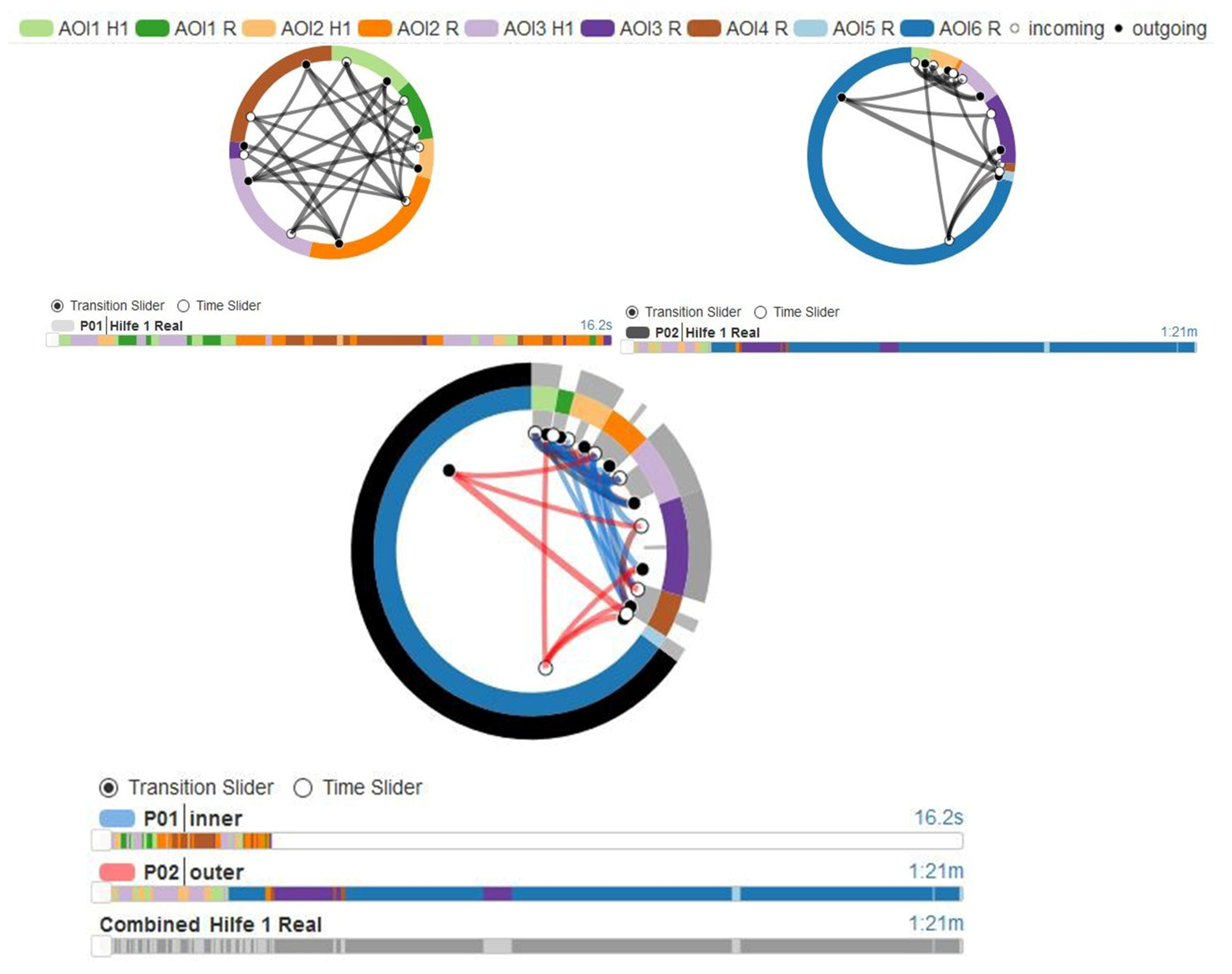

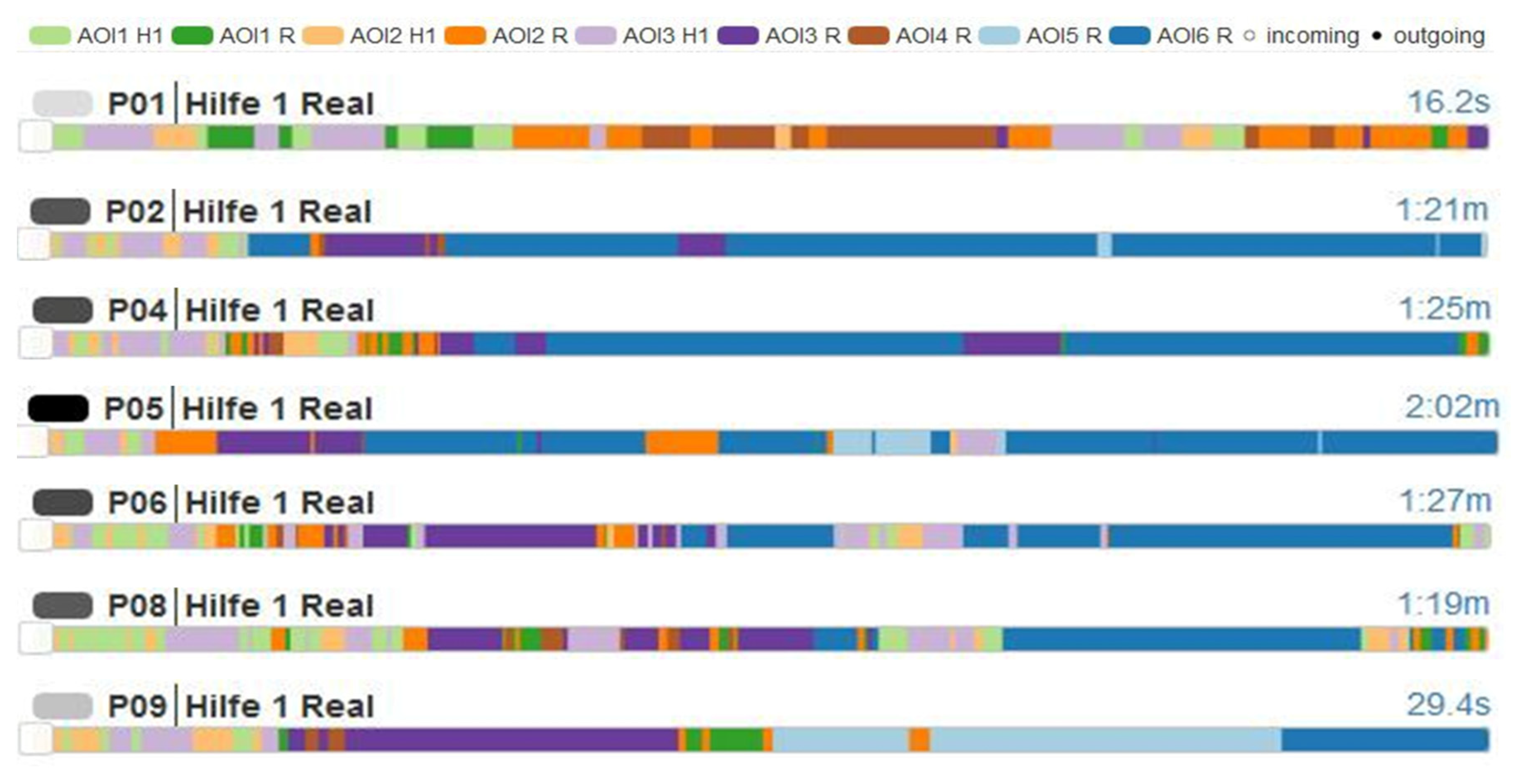

| Participant | Hint 1 | Hint 2 | Procedure during Set-Up |
|---|---|---|---|
| P01 | ✕ | ✕ | Immediately hint 1 used →no set-up → then immediately hint 2 → tried to set up → hint 2 → no correct set-up (only after hint for execution was used set-up was correctly finished) |
| P02 | ✕ | ✕ | Set-up tried (cable connected to battery and attached directly to slide, without pencil leads) → hint 1 → set up correctly finished → hint 2 used |
| P03 | - | ✕ | Set-up tried (cable connected to battery and attached directly to slide, without pencil leads) → hint 2 → set-up correctly finished → hint 2 used |
| P04 | ✕ | ✕ | Immediately hint 1 used → set-up as far as indicated in hint 1 (pencil lead attached to microscope slide) → hint 2 →set up correctly finished |
| P05 | ✕ | ✕ | Immediately hint 1 used → set-up as far as indicated in hint 1 (pencil lead attached to microscope slide + cable attached to batterie) → hint 1 → set-up correctly finished → hint 2 used |
| P06 | ✕ | ✕ | Immediately hint 1 used→ set-up as far as indicated in hint 1 (pencil lead attached to microscope slide) → hint 2 → set-up correctly finished |
| P07 | - | - | No hint for set-up used, only hint for conducting the experiment → set-up correctly finished |
| P08 | ✕ | ✕ | Immediately hint 1 used → set-up as far as indicated in hint 1 (pencil lead attached to microscope slide) → hint 2 → set-up correctly finished |
| P09 | ✕ | - | Immediately hint 1 used → set-up correctly finished |
| P10 | ✕ | ✕ | Immediately hint 1 used → cable attached to battery → hint 2 used → set-up correctly finished |
| P01 | P02 | P04 | P05 | P06 | P08 | P09 | |
|---|---|---|---|---|---|---|---|
| P01 | 0.25 | 0.40 | 0.27 | 0.43 | 0.35 | 0.35 | |
| P02 | 0.25 | 0.44 | 0.53 | 0.35 | 0.40 | 0.53 | |
| P04 | 0.40 | 0.44 | 0.48 | 0.41 | 0.61 | 0.49 | |
| P05 | 0.27 | 0.53 | 0.48 | 0.29 | 0.34 | 0.33 | |
| P06 | 0.43 | 0.35 | 0.41 | 0.29 | 0.52 | 0.34 | |
| P08 | 0.35 | 0.4 | 0.61 | 0.34 | 0.52 | 0.38 | |
| P09 | 0.35 | 0.52 | 0.49 | 0.33 | 0.34 | 0.38 |
| P01 | P02 | P03 | P04 | P05 | P06 | P08 | |
|---|---|---|---|---|---|---|---|
| P01 | 0.35 | 0.27 | 0.14 | 0.29 | 0.18 | 0.12 | |
| P02 | 0.35 | 0.46 | 0.22 | 0.80 | 0.23 | 0.26 | |
| P03 | 0.27 | 0.46 | 0.13 | 0.33 | 0.31 | 0.16 | |
| P04 | 0.14 | 0.22 | 0.13 | 0.25 | 0.4 | 0.48 | |
| P05 | 0.29 | 0.8 | 0.33 | 0.25 | 0.14 | 0.29 | |
| P06 | 0.18 | 0.23 | 0.31 | 0.4 | 0.14 | 0.36 | |
| P08 | 0.12 | 0.26 | 0.16 | 0.48 | 0.29 | 0.36 |
| Why Did You Feel You Needed the Sequential Scaffolds to Set Up the Experiment? | Did the Sequential Scaffolds Help You to Set Up the Experiment, Why Yes or Why Not? | |
|---|---|---|
| P01 | I did not know how this should be set up and could not bring the presented materials in relation to the set-up. Therefore, the help for conducting the experiment was also called. Here the set-up was clear. | The two AR scaffolds were not helpful, but the video on how to conduct the experiment was. |
| P02 | I didn’t know where to connect the mines (pencil leads) (hint 1). I only looked at the second AR hint to check that the set-up was correct. I would not have needed it to set up the experiment. | Both hints helped, but the second AR hint helped me the most. |
| P03 | Because I didn’t know exactly how to set it up and then I understood how to do it. I wanted to use as few scaffolds as possible. | This hint (hint 2) has helped me, I found it very appropriate. |
| P04 | I used both AR scaffolds because I didn’t know what to do. | The first AR hint helped me more than the second AR-hint, because I had already done everything I saw there anyway. |
| P05 | I used the AR scaffolds because otherwise I wouldn’t have known how to set up the experiment. | I found the second AR-help the most helpful where you can see the whole setup. |
| P06 | I used both AR scaffolds because I didn’t know exactly what to do with the materials. | Yes, both hints were very helpful, so I knew how to do it and then did it correctly. I think the first AR hint for the set up I would not have needed, but only the second AR hint. |
| P07 | I made sure to use a help when I needed it. I have not needed more than one help (just called the video hint for conducting the experiment). | Yes, the hint (video hint) has helped me. |
| P08 | I only used the first AR hint, because then I already knew what to do. | The first AR hint helped me. The content of the hint was clear. |
| P09 | I used the first AR hint because I did not know exactly how to attach the mines to the cables and how that should work with the adhesive tape. Otherwise, I didn’t need any hint. | Yes, the AR hint was helpful. The experiment was not so difficult and it was good to understand. |
| P10 | I was curious what is represented in the two AR hints, but the first AR hint I have needed in any case. | I have found both AR hints helpful in any case.P10 further said that it was positive, that new things were experienced during the experiment. |
Disclaimer/Publisher’s Note: The statements, opinions and data contained in all publications are solely those of the individual author(s) and contributor(s) and not of MDPI and/or the editor(s). MDPI and/or the editor(s) disclaim responsibility for any injury to people or property resulting from any ideas, methods, instructions or products referred to in the content. |
© 2023 by the authors. Licensee MDPI, Basel, Switzerland. This article is an open access article distributed under the terms and conditions of the Creative Commons Attribution (CC BY) license (https://creativecommons.org/licenses/by/4.0/).
Share and Cite
Fleischer, T.; Deibl, I.; Moser, S.; Strahl, A.; Maier, S.; Zumbach, J. Mobile Eye Tracking during Experimenting with Digital Scaffolding—Gaze Shifts between Augmented Reality and Experiment during Zinc Iodide Electrolysis Set-Up. Educ. Sci. 2023, 13, 170. https://doi.org/10.3390/educsci13020170
Fleischer T, Deibl I, Moser S, Strahl A, Maier S, Zumbach J. Mobile Eye Tracking during Experimenting with Digital Scaffolding—Gaze Shifts between Augmented Reality and Experiment during Zinc Iodide Electrolysis Set-Up. Education Sciences. 2023; 13(2):170. https://doi.org/10.3390/educsci13020170
Chicago/Turabian StyleFleischer, Timo, Ines Deibl, Stephanie Moser, Alexander Strahl, Simone Maier, and Joerg Zumbach. 2023. "Mobile Eye Tracking during Experimenting with Digital Scaffolding—Gaze Shifts between Augmented Reality and Experiment during Zinc Iodide Electrolysis Set-Up" Education Sciences 13, no. 2: 170. https://doi.org/10.3390/educsci13020170
APA StyleFleischer, T., Deibl, I., Moser, S., Strahl, A., Maier, S., & Zumbach, J. (2023). Mobile Eye Tracking during Experimenting with Digital Scaffolding—Gaze Shifts between Augmented Reality and Experiment during Zinc Iodide Electrolysis Set-Up. Education Sciences, 13(2), 170. https://doi.org/10.3390/educsci13020170





